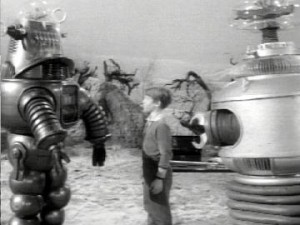Interview With DIY Robotics Guru Gordon McComb

-RBB Press ReleaseEnough said on our part, let the interview begin! Q. Could you please start by giving us a brief history of the Robot Builder's Bonanza's odyssey?
I began the original edition of Robot Builder's Bonanza (“RBB”) in the mid-1980’s, during a major resurgence of interest in robotics. I couldn’t afford the ready-made bots of the time — the HERO, RB5X, Gemini, Androbot, and others — so I had to build my own. I thought about ways to simplify the projects I read about in books and magazines, and developed what was then new approaches to construction.
With each new edition I’ve tried to take a fresh look at how people with a modest budget and a minimum of tools can create their own robots. In the fourth edition, for example, almost all of the project plans are based on making only straight, simple cuts. You don’t need special tools or skills.
The fourth edition also embraces the latest low-cost microcontrollers, and the new fusion of affordable all-in-one sensors and breakout boards. It talks about how to hook these up and use them with your own custom robot.
Q. Is it possible to know (even approximately) how many copies of this book have been sold in the world so far, all editions included?No one really know for sure because of the accounting system used by the original publisher of the first edition. Estimates are several hundred thousand copies of the book have been printed so far. For over a decade the book was featured in various book clubs, and was a major seller through mail order.
Q. How does the content of the new edition compare to the previous one? Can you give us a highlight of its new features?The book has been heavily revised, and took over a year to write. There are 10 all new robot construction plans, demonstrating building robots using a variety of materials, including wood, plastic, and metal. The new plans include a compact six-legged hexabot, a small but very functional revolute coordinate arm, and a unique but cheap-to-build gripper system.
A lot of attention was made to expanding the discussion of such things as understanding and using electronic components, the proper use of tools, and all levels of electrical and mechanical construction. The fourth edition contains about 30% more text and graphics, and they redesigned the interior of the book to accommodate the extra material. I also off-loaded content to the Robotoid.com support site in order to make room for new chapters.
Q. Using microcontrollers is always a big aspect of building robots. Did you reserve an important place to the open source Arduino phenomenon of the last years?The Arduino factors heavily in the fourth edition of RBB. There’s a new “getting started” chapter on the Arduino, plus many of the projects that interface to a microcontroller include Arduino hookups and code sketches.
I also added coverage of the PICAXE, another microcontroller that’s popular among robo-builders. Several projects in the book demonstrate using special features of the PICAXE, such as its built-in support for reading infrared remote control signals.
Q. We know the book has a companion website at Robotoid.com. It looks like a true paradise for all roboticists and especially for people building their first robot. Could you please give us an overview of what we can find on this website?Robot Builder’s Bonanza, Fourth Edition is supplemented with what I call the “RBB Online Support site,” at Robotoid.com. (By the way, the name “robotoid” comes, in part, from a particularly bad episode of the old Lost in Space television series that features Robby the Robot — originally seen in the movie Forbidden Planet — as a very naughty bot.)
The support site has all the microcontroller source code from the book, of course, plus bonus projects like an advanced 12-servo hexapod, printable cutting and drilling templates, parts sources, and “app notes,” mini-articles on all sorts of interesting robotics topics. I add new material on a weekly basis.
Also on the Support site is my Arduino-based ArdBot Project originally published in SERVO Magazine, plus My First Robot, a collection of lessons for getting started in robotics. Access to the support site is free, and does not require registration or membership.
Q. Is Robot Builder's Bonanza appropriate for teaching robotics at schools or for educational institutions in general? Would you recommend it for teachers starting a robotic class?While RBB is not a textbook, it’s been used as a hands-on robot building guide in various classrooms. I like to think of RBB as a point of inspiration. It’s a compendium of robot facts and ideas, rather than a how-to on constructing one, basic robot. Since the projects are modular, students are free to build their own unique creation. That’s always been an important part of RBB, and why it’s remained popular all these years.
Q. Does the 4th edition of Robot Builder's Bonanza continue to offer a list of sources of where to buy robots and robot parts? Do you have your favourite places to shop? How have you tested their service quality before recommending them in your book?The bulk of the source listings have been moved to the RBB Online Support site, where links to important retailers are now maintained. The lists are categorized, and I've purchased from just about all the retailers in the main Robotics category. (On those I didn't, I got recommendations from close friends.)
I have often placed “secret shopper” orders, in case someone at the online store recognized my name. And before you ask, not all passed muster. Those that failed weren't included. You might be interested to know that I secret-shopped at RobotShop.com during the writing of the fourth edition, and you should be proud that you passed with flying colors!
Q. What do you see for the future of robotics? What role are hobbyists playing in the advancement of robotics today?Robotics is what I call inspired technology, using the affordable materials and electronics involved in building robots to learn about cutting edge technologies used in aerospace, microbiology, marine science, artificial intelligence, psychology, and other disciplines. Whether or not someone perfects their beer-fetching robot doesn't matter. Robotics is a journey; the destination is what you've learned along the way, and how you use that knowledge to better yourself, and the world.
Ten years ago robot hobbyists were experimenting with all the gadgets common in today’s smart phones — digital compasses, accelerometers, GPS, touch screens, microcontrollers. I am sure at least some of these technologies found their way into so many modern consumer electronics because their designers had first-hand experience while building a robot at home or school.
Q. What is next for you? Can you give us a sneak peek or scoop about your future projects?I'm currently working on a new book that concentrates just on fun projects with the Arduino. It’ll be out first part of 2012. I'm also stepping up my contributions to magazine such as SERVO, Nuts & Volts, and MAKE, concentrating on affordable DIY projects that teach while they entertain. Components like the Arduino and PICAXE, plus their easy availability through customer-centric retailers like RobotShop, are making fundamental changes in the Build-It community.
Thanks for helping to keep our community civil!
This post is an advertisement, or vandalism. It is not useful or relevant to the current topic.
You flagged this as spam. Undo flag.Flag Post




